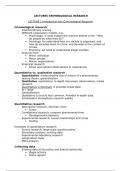LECTURES CRIMINOLOGICAL RESEARCH
LECTURE 1 Introduction into Criminological Research
Criminological research
- Interdisciplinary science
- Different explanatory models, e.g.:
Psychology: it could explain the motives behind crime. “Why
do people do what they do?”
Sociology: to understand how our society is organised, and
how do societies react to crime, and develop in the context of
crimes.
Economy: we need to understand illegal markets
- Analysis level:
Micro: individual
Meso: groups
Macro: organisations
- Empirical research:
Direct and indirect observations or experiences
Quantitative vs. qualitative research
- Quantitative: measuring the size of nature of a phenomenon;
testing theory, generalisation.
- Qualitative: exploratory; in-depth interviews; observations; media
research
- Quantitative is dominant. It provides broad data.
- N = large
- Generalisation
- Qualitative is (much) less common. Provides in-depth data.
- Combination strengthens research quality
Quantitative research
- Descriptive research; describe crime
Scope
- Correlational research; compare phenomena/crime
Development/coherence
- Experimental research; causal relationships and crime
Testing
Examples of quantitative research:
- Survey research; large-scale questionnaires
- Secondary analysis; existing data
- Experimental laboratory research
- Longitudinal study
- Meta-analysis
Collecting data
- Existing data at the police and judicial authorities
Illegal activity
Police reports
, Criminal cases
- Non-judicial data (such as statistics)
Central Bureau of Statistics (CBS)
Crime and law enforcement (WODC & CBS)
United Nations: UNSTATS & UNODC
- Victim or offender surveys
Safety monitor, CBS, Police monitor
- Self-report surveys
WODC
Dark number
- Only a fraction of illegal activities is registered
- A large amount of data is missing
Not every human trafficker is caught – in fact, most are not!
Alternative
- Combining different sources (self-report, offender surveys, victim
surveys)
- Combining research methods (qualitative/quantitative)
Non-response
- High non-response in criminological research
- People refuse to answer a question because it is about crime
- The same applies to participation in the research
Empirical cycle
Observation induction Deduction Testing
Evaluation
1. Observation:
- An idea arises from observation
- Something to explore
- Literature study to determine what is known
- Example: banga list
2. Induction
- Formulate an abstract research question
- Guiding cause and measurable effect
- From specific to a generalisation/theory
- Propositions and concepts
- Example: do students consider the banga list as harmful?
3. Deduction
- Specific general theory
- Develop a workable hypothesis
- From the general/theory to the particular
- Operationalise
4. Testing
- Conducting research
, - Collect data
- Analysing/testing
5. Evaluation
- Confirm or reject hypothesis/theory
- Sufficient evidence?
- Theory can be:
Adjusted
Expanded
Improved
Population and sample
- Population = the collection of all research units
For example: all UU students
- Sample = a subset of the population. We collect data from the
research units. This group represents the population
For example: UU lecture students
- The sample size is represented by the letter N.
- Sample contains characteristics of the population
Selective vs. random sampling
- Random: each member of the subset has an equal probability of
being chosen
- Selective
This course will be mainly focused on qualitative methods (dominant in
UU).
Concepts of qualitative approach (KNOW FOR EXAM!!!)
- Explorative (no testing): exploring potential different answers to our
question, but without testing
- Interpretive: to understand and to interpret, we are interested in the
point of view of the people we are researching.
- Constructivist (social, cultural, etc.): based on the idea (so also data)
that reality is social and a cultural construct. A researcher doesn’t
find data, he creates data.
- Inductive (data to theory): from reality to a theory, it is going up.
Deduction is the opposite: from an idea to the reality.
We don’t start with hypothesis; we often do not even know the
theories.
Sensitizing concepts: we start the journey with some concepts,
but we don’t have a theory to start with.
- Holistic (all aspects): we try to analyse many (or all)
aspects/relationships of the phenomenon.
- Contextual (focus ‘in’ context): needing to understand the social,
political, historical, etc. context of the phenomenon. We understand
data in context.
- Cyclical and iterative (repeat): qualitative research is a loop.
- Primary data (first-hand, fieldwork): statistics that already has been
done by others is secondary data.
, Why focus on qualitative methods in criminology?
- More in-depth, but that is in any field of knowledge, not specifically
for criminology.
- Experiments are difficult or impossible
- Official crime statistics are limited (dark number) and politically
loaded (crime numbers = hot issues)
The problem with focus on numbers
- Survey data on sensitive topics: gap between attitudes (words) and
social practices (deeds).
Social desirability in surveys
Many fields in which it is impossible to do surveys (“how much
cocaine do you have traded?”)
Clear gap in what people say about crime, and what people do
about/in crime.
- Unrecorded fields such as organised, corporate, white collar and
state crime. Also group or gender violence, fraud, drug trafficking
and use, green or digital crimes, etc.
Qualitative research designs (in criminology)
- Cross-sectional or snapshot (one moment): a study at one particular
point in time.
- Longitudinal (more measures, in order to see development)
- Retrospective (biography, life history, perceptions before and after
intervention, historical): research aimed to systematically
reconstruct the past. You want to analyse development in the past.
- Comparative (also meta-level and parallel studies)
- Case study (n=1)
- Ethnographic (small groups, thick descriptions, Verstehen)
Practical Cycle of Qualitative Research
Data collection methods
- Interviews (individual or focus groups).
- (Participant) observation in situations / locations within groups,
networks, organisations, etc.
- (Auto)biography / life histories
- Discourse analysis of text, images, sound or art (photos, film, videos,
songs, etc.)
- All of the above … ONLINE (digital, virtual, etc.)





